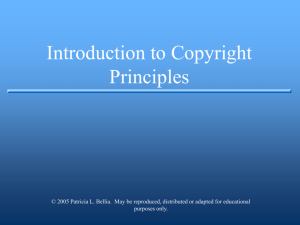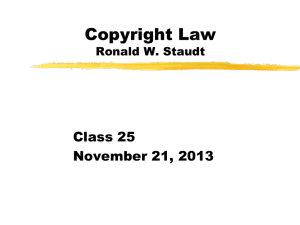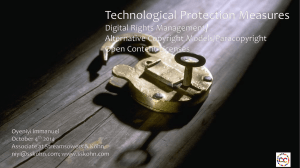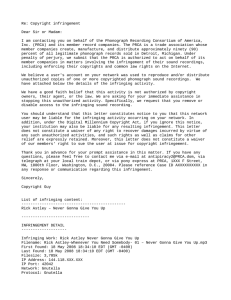U.S. Supreme Court Rules Companies Promoting
advertisement
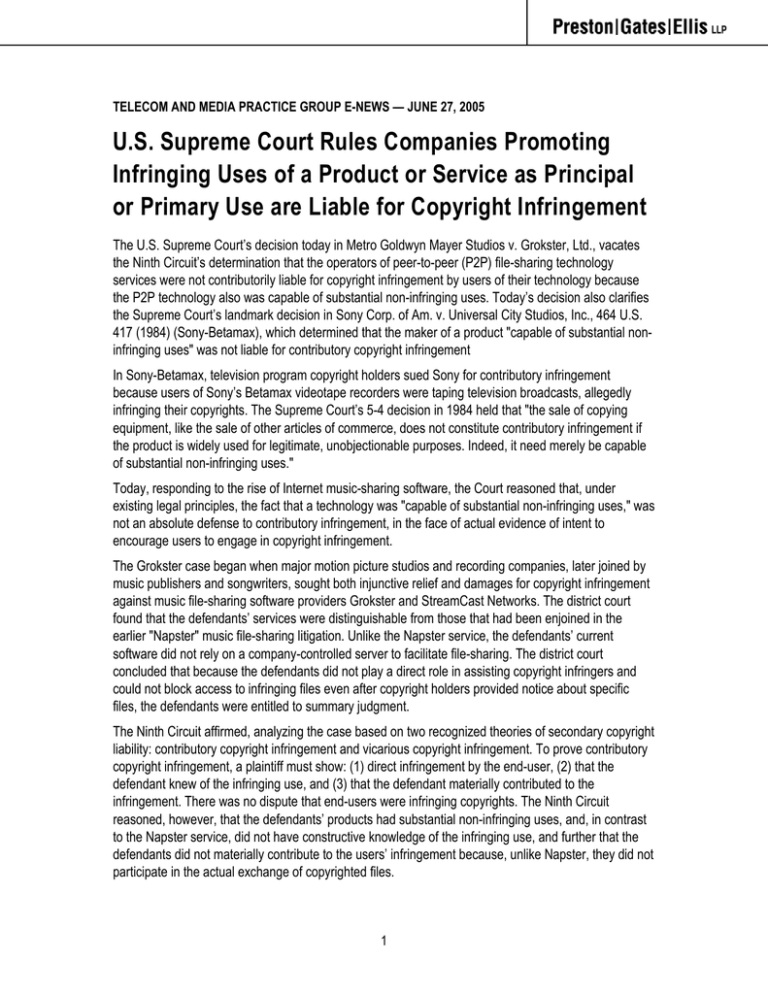
TELECOM AND MEDIA PRACTICE GROUP E-NEWS — JUNE 27, 2005 U.S. Supreme Court Rules Companies Promoting Infringing Uses of a Product or Service as Principal or Primary Use are Liable for Copyright Infringement The U.S. Supreme Court’s decision today in Metro Goldwyn Mayer Studios v. Grokster, Ltd., vacates the Ninth Circuit’s determination that the operators of peer-to-peer (P2P) file-sharing technology services were not contributorily liable for copyright infringement by users of their technology because the P2P technology also was capable of substantial non-infringing uses. Today’s decision also clarifies the Supreme Court’s landmark decision in Sony Corp. of Am. v. Universal City Studios, Inc., 464 U.S. 417 (1984) (Sony-Betamax), which determined that the maker of a product "capable of substantial noninfringing uses" was not liable for contributory copyright infringement In Sony-Betamax, television program copyright holders sued Sony for contributory infringement because users of Sony’s Betamax videotape recorders were taping television broadcasts, allegedly infringing their copyrights. The Supreme Court’s 5-4 decision in 1984 held that "the sale of copying equipment, like the sale of other articles of commerce, does not constitute contributory infringement if the product is widely used for legitimate, unobjectionable purposes. Indeed, it need merely be capable of substantial non-infringing uses." Today, responding to the rise of Internet music-sharing software, the Court reasoned that, under existing legal principles, the fact that a technology was "capable of substantial non-infringing uses," was not an absolute defense to contributory infringement, in the face of actual evidence of intent to encourage users to engage in copyright infringement. The Grokster case began when major motion picture studios and recording companies, later joined by music publishers and songwriters, sought both injunctive relief and damages for copyright infringement against music file-sharing software providers Grokster and StreamCast Networks. The district court found that the defendants’ services were distinguishable from those that had been enjoined in the earlier "Napster" music file-sharing litigation. Unlike the Napster service, the defendants’ current software did not rely on a company-controlled server to facilitate file-sharing. The district court concluded that because the defendants did not play a direct role in assisting copyright infringers and could not block access to infringing files even after copyright holders provided notice about specific files, the defendants were entitled to summary judgment. The Ninth Circuit affirmed, analyzing the case based on two recognized theories of secondary copyright liability: contributory copyright infringement and vicarious copyright infringement. To prove contributory copyright infringement, a plaintiff must show: (1) direct infringement by the end-user, (2) that the defendant knew of the infringing use, and (3) that the defendant materially contributed to the infringement. There was no dispute that end-users were infringing copyrights. The Ninth Circuit reasoned, however, that the defendants’ products had substantial non-infringing uses, and, in contrast to the Napster service, did not have constructive knowledge of the infringing use, and further that the defendants did not materially contribute to the users’ infringement because, unlike Napster, they did not participate in the actual exchange of copyrighted files. 1 To prove vicarious copyright infringement, a plaintiff must show: (1) direct infringement by the end-user, (2) that the defendant benefited financially from the infringement, and (3) that the defendant had the right and ability to supervise the infringers. There was no dispute that end-users were infringing copyrights, or that the defendants benefited financially from the use of their products. The Ninth Circuit concluded, however, that the defendants had no ability to supervise the infringers because once again, unlike Napster, the defendants did not participate in the actual exchange of copyrighted files. The Ninth Circuit also noted that, in their software licensing agreements with users, defendants had not reserved any right to block illegal use of their products. In addition, although it may have been possible for the defendants to modify their software to enable blocking in future versions, the court considered this irrelevant on the issue of whether vicarious liability existed for current versions. The Supreme Court granted certiorari in 2004 and heard oral arguments on March 29, 2005. The Court’s unanimous decision is noteworthy in its attention to the actual activities of the defendant companies, and the actual, known conduct of the users of the defendants’ services. For example, the Court noted that "Grokster and StreamCast are not … merely passive recipients of information about infringing use. The record is replete with evidence that from the moment Grokster and StreamCast began to distribute their free software, each one clearly voiced the objective that recipients use it to download copyrighted works, and each took active steps to encourage infringement." The Court further described the actual operation of the defendants’ businesses: In addition to this evidence of express promotion, marketing, and intent to promote further, the business models employed by Grokster and StreamCast confirm that their principal object was use of their software to download copyrighted works. Grokster and StreamCast receive no revenue from users, who obtain the software itself for nothing. Instead, both companies generate income by selling advertising space, and they stream the advertising to Grokster and Morpheus users while they are employing the programs. As the number of users of each program increases, advertising opportunities become worth more. … While there is doubtless some demand for free Shakespeare, the evidence shows that substantive volume is a function of free access to copyrighted work. Users seeking Top 40 songs, for example, or the latest release by Modest Mouse, are certain to be far more numerous than those seeking a free Decameron, and Grokster and StreamCast translated that demand into dollars. The Court then explained that the Ninth Circuit had misapplied the law regarding contributory or vicarious liability for infringement, by overstating the protection from liability that technologies with both infringing and non-infringing uses should have: We agree with MGM that the Court of Appeals misapplied Sony, which it read as limiting secondary liability quite beyond the circumstances to which the case applied. Sony barred secondary liability based on presuming or imputing intent to cause infringement solely from the design or distribution of a product capable of substantial lawful use, which the distributor knows is in fact used for infringement. The Ninth Circuit has read Sony’s limitation to mean that whenever a product is capable of substantial lawful use, the producer can never be held contributorily liable for third parties’ infringing use of it. … This view of Sony, however, was error, converting the case from one about liability resting on imputed intent to one about liability on any theory. Because Sony did not displace other theories of secondary liability, and because we find below that it was error to grant summary 2 judgment to the companies on MGM’s inducement claim, we do not revisit Sony further, as MGM requests, to add a more quantified description of the point of balance between protection and commerce when liability rests solely on distribution with knowledge that unlawful use will occur. It is enough to note that the Ninth Circuit’s judgment rested on an erroneous understanding of Sony and to leave further consideration of the Sony rule for a day when that may be required. … Sony’s rule limits imputing culpable intent as a matter of law from the characteristics or uses of a distributed product. But nothing in Sony requires courts to ignore evidence of intent if there is such evidence, and the case was never meant to foreclose rules of fault-based liability derived from the common law. … Thus, where evidence goes beyond a product’s characteristics or the knowledge that it may be put to infringing uses, and shows statements or actions directed to promoting infringement, Sony’s staple-article rule will not preclude liability. … [T]he inducement rule, too, is a sensible one for copyright. We adopt it here, holding that one who distributes a device with the object of promoting its use to infringe copyright, as shown by clear expression or other affirmative steps taken to foster infringement, is liable for the resulting acts of infringement by third parties. We are, of course, mindful of the need to keep from trenching on regular commerce or discouraging the development of technologies with lawful and unlawful potential. Accordingly … mere knowledge of infringing potential or of actual infringing uses would not be enough here to subject a distributor to liability. Nor would ordinary acts incident to product distribution, such as offering customers technical support or product updates, support liability in themselves. The inducement rule, instead, premises liability on purposeful, culpable expression and conduct, and thus does nothing to compromise legitimate commerce or discourage innovation having a lawful promise. … The Court then applied existing law concerning contributory and vicarious liability for infringement, but reached a very different conclusion than the Ninth Circuit in its application of that law to the facts presented: There is substantial evidence in MGM’s favor on all elements of inducement, and summary judgment in favor of Grokster and StreamCast was error. On remand, reconsideration of MGM’s motion for summary judgment will be in order. In sum, applying the Court’s ruling today, those involved in distributing technologies that may be used for infringing as well as non-infringing activities should be aware of how the Court’s new decision has clarified the liability rules for contributory copyright infringement. The Court’s decision today confirms that technology distributors that knowingly promote and encourage infringing activity may be liable for copyright infringement. Evidence of intent, as well as evidence of actual infringing use, is key to this analysis. However, "mere knowledge of infringing potential or of actual infringing uses would not be enough … to subject a distributor to liability." Some key questions for technology distributors to evaluate in light of the Court’s decision include: Does the company directly benefit from infringement? Is the company’s business plan viable if revenues or benefits resulting from infringing uses of the technology are excluded? 3 Does the marketing or provision of ongoing services to users encourage or induce infringing activity? Does the company specifically target demand for infringing uses? Are most uses of the technology actually infringing uses? Does the technology, as marketed, have substantial or commercially significant non-infringing uses that are credible? Could the company limit infringing activity? Does the company make an effort to respond to allegations of infringement and prevent infringement? The complete U.S. Supreme Court decision, with citations to the cases discussed above, may be found at: http://www.supremecourtus.gov/opinions/04slipopinion.html 4
